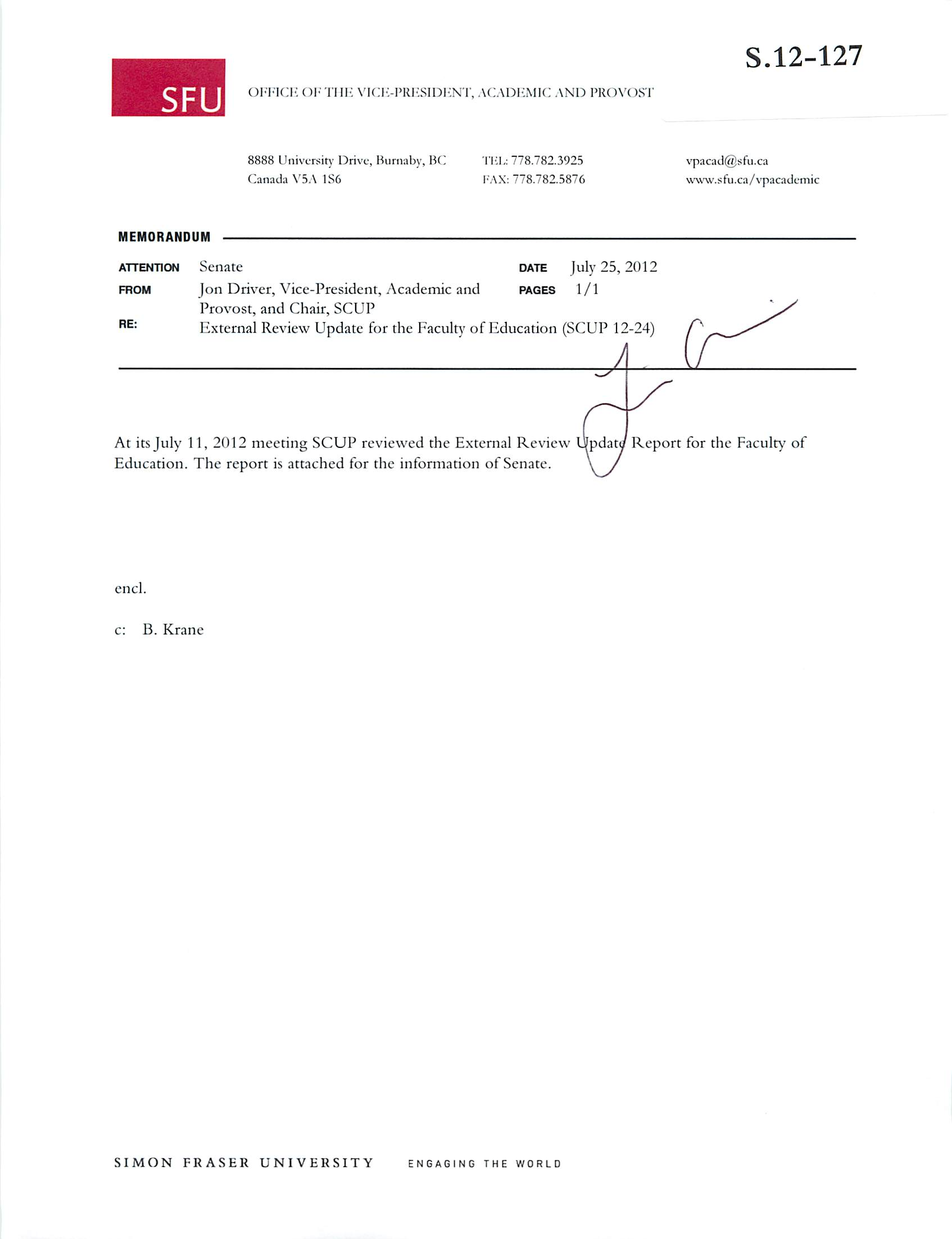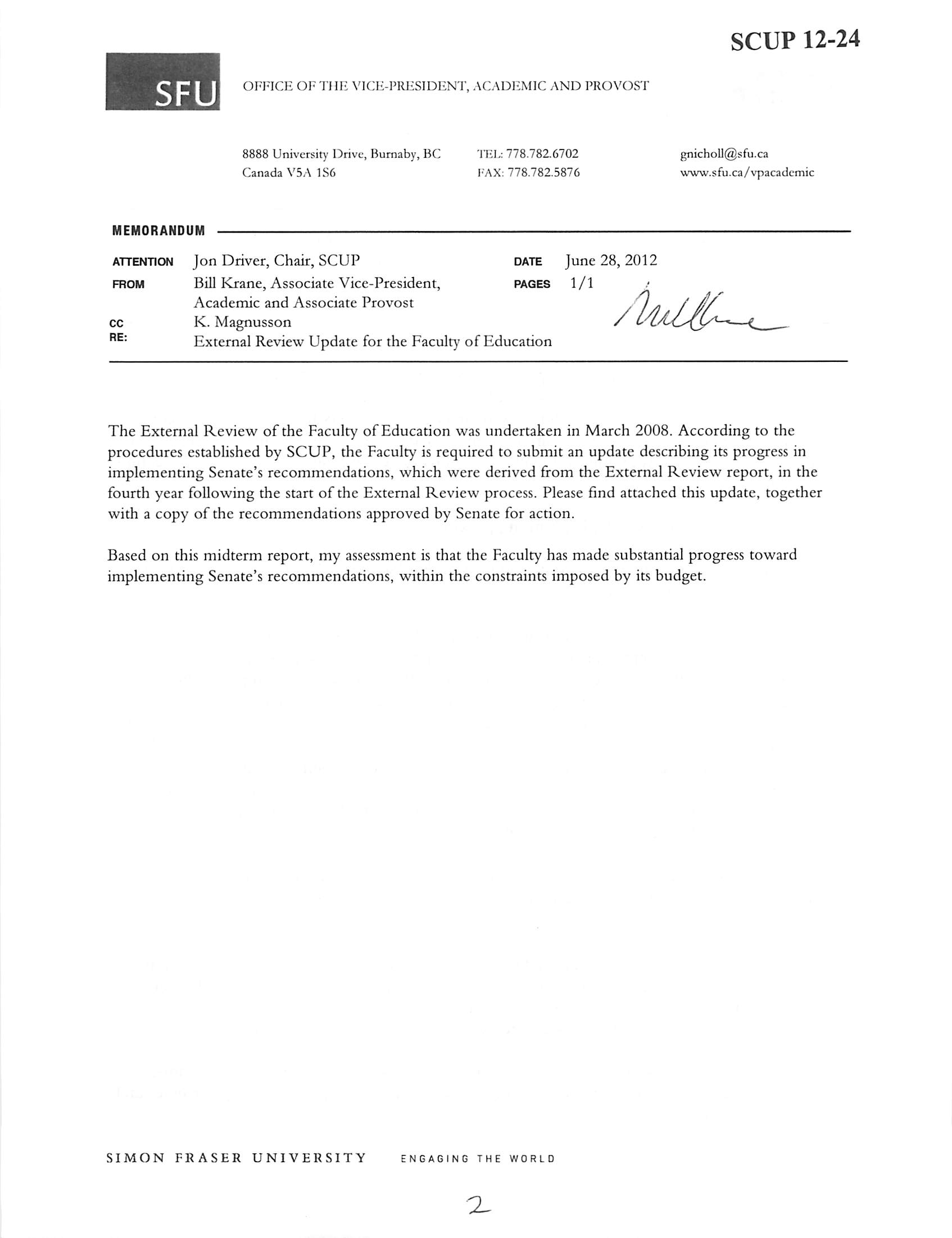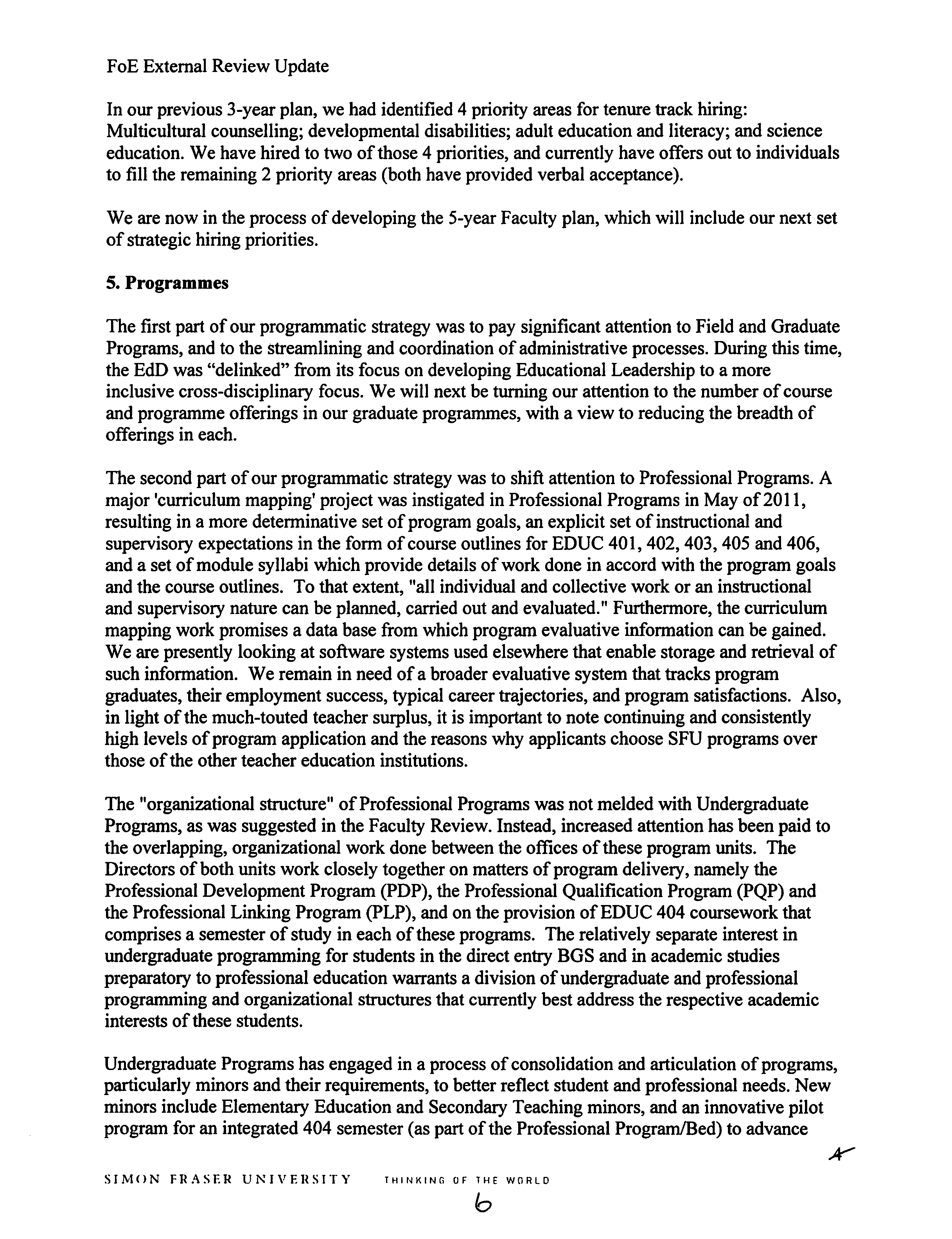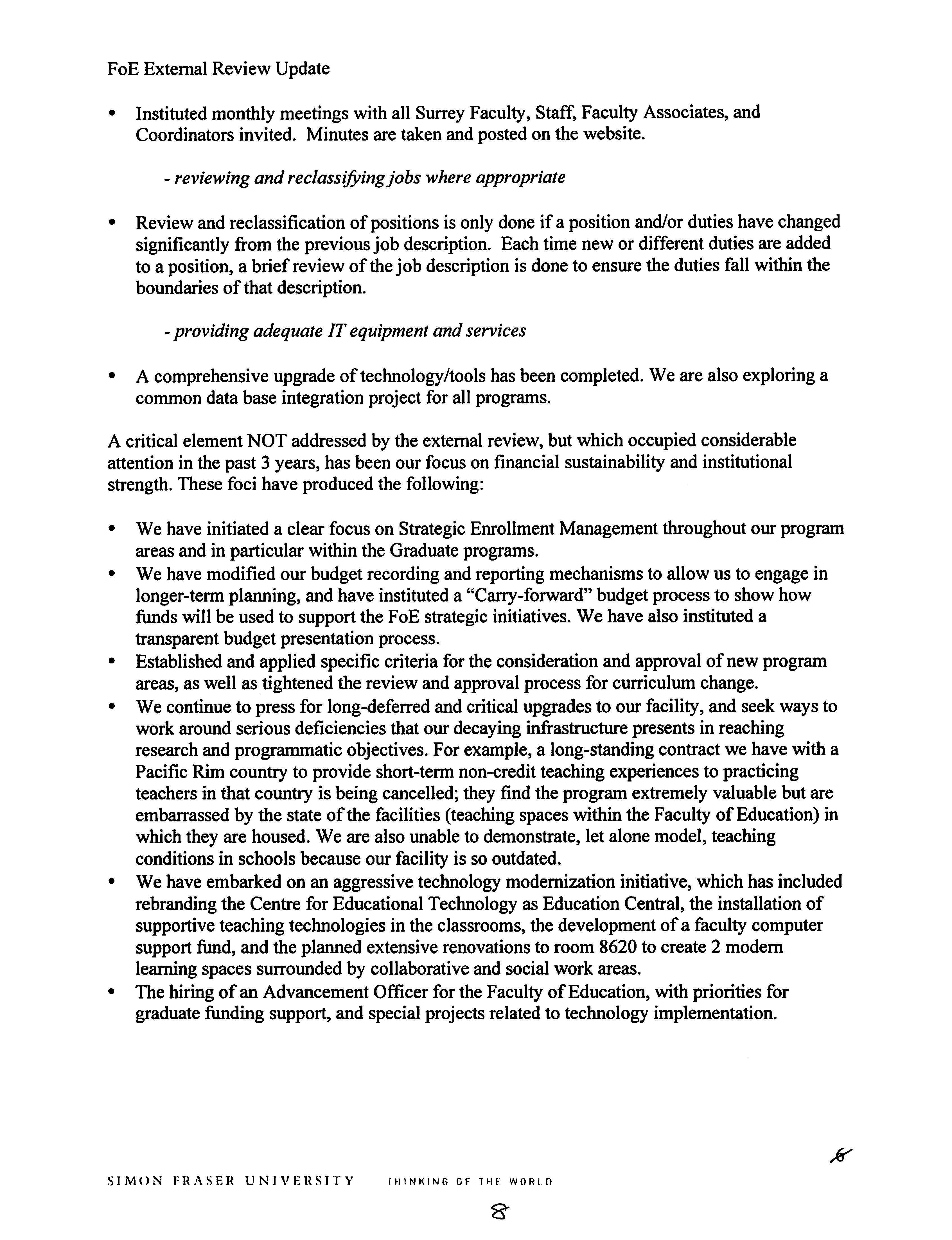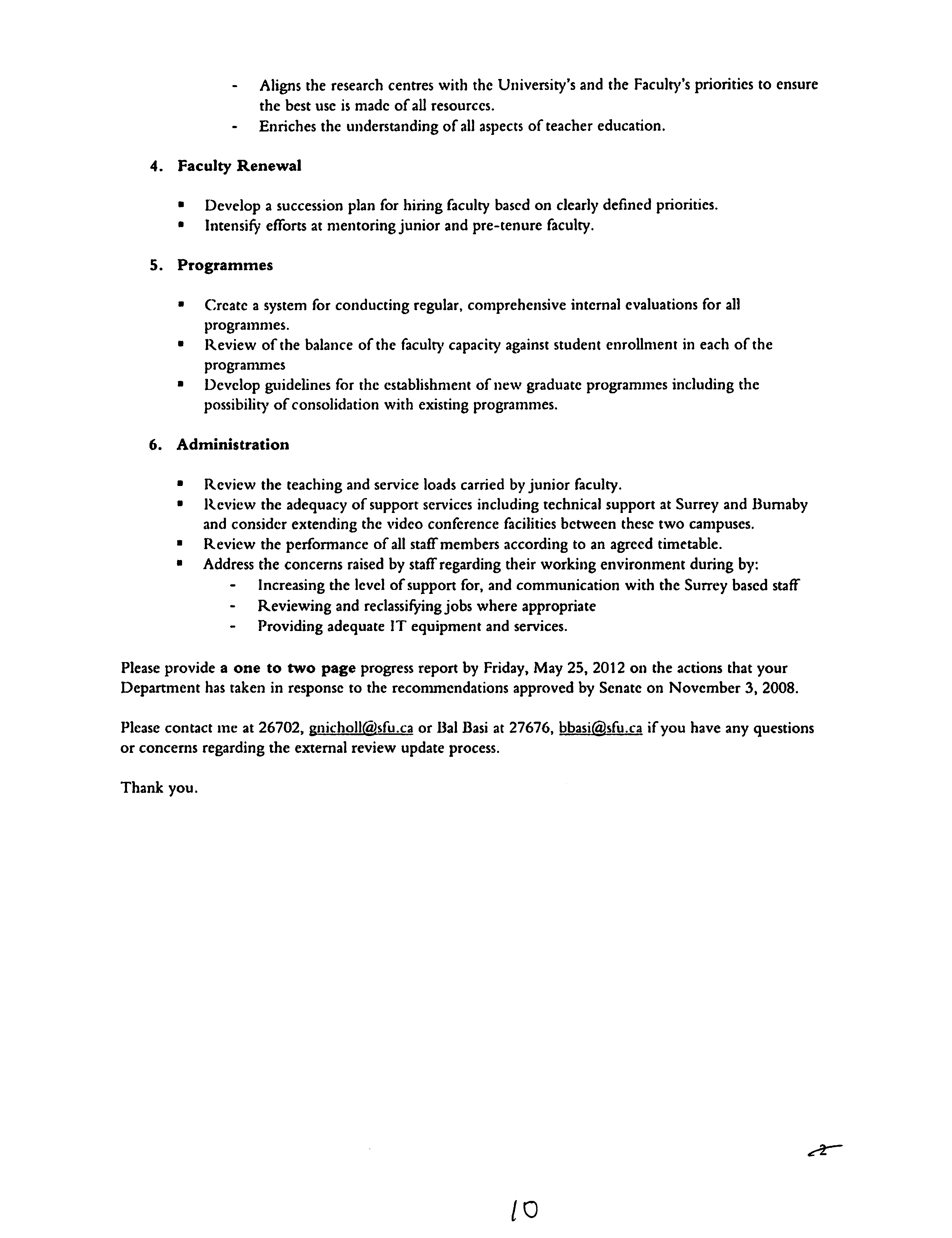SFU
MEMORANDUM
OFFICE OFTHEVICI'-I'RI'SIDI'.N'I,.\(;.\Di:.MIC.\Nl) PROVOST
University Drive, Burnaby, BC
Canada \'5.\ 1S6
TEL: 778.782.3925
FAX: 778.782.5876
ATTENTION
Senate
date
July 25,2012
from
Jon Driver, Vice-President, Academic and
pages
1/1
Provost, and Chair, SCUP
RE:
External Review Update for the Faculty of Education (SCUP 12-24)
S.12-127
At its July 11, 2012 meeting SCUP reviewed the External Review
Education. The report is attached for the information of Senate.
Report for the Faculty of
encl.
c: B. Krane
SIMON FRASER UNIVERSITY
ENGAGING THE WORLD
SFU
OFFICE OF THE VICE-PRESIDENT, ACADEMIC AND PROVOST
University Drive, Burnaby, BC
Canada V5A 1S6
TEL 778.782.6702
FAX: 778.782.5876
MEMORANDUM
attention
Jon Driver, Chair, SCUP
FROM
Bill Krane, Associate Vice-President,
Academic and Associate Provost
cc
K. Magnusson
External Review Update for the Faculty of Education
RE:
date
June 28,2012
PAGES
1/1
/l4jL
SCUP 12-24
The External Review of the Faculty of Education was undertaken in March 2008. According to the
procedures established by SCUP, the Faculty is required to submit an update describing its progress in
implementing Senate's recommendations, which were derived from the External Review report, in the
fourth year following the start
of the External Review process. Please find attached this update, together
with a copy of the recommendations approved by Senate for action.
Based on this midterm report, my assessment is that the Faculty has made substantial progress toward
implementing Senate's recommendations, within the constraints imposed by its budget.
SIMON FRASER UNIVERSITY
ENGAGING THE WORLD
2-
FACULTY OF EDUCATION
Office of the Dean
Education Building EDB 8525
8888 University Drive, Burnaby, BC
FAX 778.782.4576
Canada V5A 1S6
MEMORANDUM -
ATTENTION:
Glynn Nicholls
DATE:
May 15, 2012
FROM:
PAGES:
1/6
RE:
External Review Update,
Faculty ofEducation
The Faculty of Education is pleased to provide this brief progress report on actions taken by the
Faculty in response to the recommendations of the 2008 external Review of the Faculty. For
brevity sake, we have reported on actions taken under each ofthe six headings, with the core
recommendation indicated in italics. Furthermore, the categories are not mutually exclusive; for
example, a number of"Programmes Recommendations" (section 5) are described under Section
1 (strategic planning).
1. Faculty Strategy, and strategic planning processes.
An agreed upon set
ofpriorities or goals against which all individual and collective work can be
planned, carried out and evaluated.
• In August of 2009, we completely
redrafted our 3-Year Academic Plan.
The Academic
Plan reflected the recommendations from the external review, as well as a process of faculty
consultation, feedback and revisions. We are now inthe 3rd year ofplan implementation;
programming and budget decisions have been made in relation to the plan. Copies of the
Academic Plan as well as a 2011 report documenting progress towards that plan are available
on request.
• Instituted
Executive planning retreats.
In early September ofeach year, an Executive
(Program Directors, Associate Deans, Dean) retreat is held. Priorities for action for the
coming year in relation to the 3-Year Plan are identified, and then update reports are
provided at the biweekly Executive meetings throughout the year.
A structure oforganizational units that best suits the achievements ofthese priorities, more
closely aligns with the operation ofthe Faculty, and supports its various undergraduate,
graduate andprofessionalprogrammes.
• Developed and implemented a new administrative structure incorporating Field Programs
and Graduate Programs into the portfolio ofa new Associate Dean Graduate Studies and
Research in Education. In turn, this new administrative unit:
o Produced a report to the Dean providing 13 recommendations for priorities and
actions in graduate studies,
o Developed a framework for a program review ofthe various graduate programs,
which uses common metrics to compare and contrast program delivery attributes and
efficiencies.
SIMON FRASF.R UNIVERSITY
thinking of the world
3
FoE External Review Update
o Developed and applied a framework/guidelines for use by the Graduate Programs
Committee in considering proposals for new programs. The framework is used to
evaluate proposed new programs using the criteria of documented need/demand,
fidelity to the faculty's strategic directions/priorities, current instructional capacity to
deliver the program, and sustainability
o Established an annual schedule for collection and analysis
of information needed for
enrollment management.
o Implemented two-year financial support packages offered to top PhD applicants as a
means
of improving recruitment outcomes.
• Restructured the non-departmentalized units to increase the articulation between Field
Programs and Graduate Studies as well as Teacher Education Programs and Undergraduate
Programs.
• Created the Office ofIndigenous Education within the faculty.
•
Revised the mandate and operations
of the Office ofInternational Education, and instituted a
Faculty
of Education Internationalization Committee.
A review ofdecision making structures andprocesses to ensureclarity ofauthority and a high
degree oftransparency.
• Developed, ratified, and published a Faculty Governance structure in service of transparency
and explicit articulation of decision-making pathways;
• Instituted formal procedures for Executive Meetings, with clear indication of
discussion/action items, and publicizing agendas/minutes.
2. Communication
Continue to seek ways ofincreasing communication betweenfaculty and staffmembers at the
three campuses including the use oftechnology, a webportal and the consideration ofthe
introduction ofan annual retreat.
[NOTE: We do not have, nor have we ever had, staffor faculty permanently based at the
Vancouver Campus. Therefore, reference will be made to work done to better link the Burnaby
and Surrey campus activities.]
•
Completely rebuilt the Faculty of Education website on the CQ5 CMS platform. The
platform switch also enabled a complete redesign and clean up of the multiple site
components.
v
• Instituted an annual Faculty retreat in 2011; the second such retreat is scheduled for June,
2012
•
Developed video-conferencecapacity for inter-campus meeting attendance (please refer to
Section 6 for details)
3. Research
Develop afaculty research strategy that:
Defines how research excellence is assessed.
SIMON FRASER UNIVERSITY
thinking of the world
H
FoE External Review Update
Connects the research interests and agendas through informalandformal means as well as
individual and group efforts.
Provides mechanisms
for intellectual exchange among all areas ofthe Faculty.
Aligns the research centres with the University's and the Faculty's priorities to ensure the best
use is made ofall resources.
Enriches the understanding ofall aspects ofteacher education
•
The TPC examined and refined conceptions of scholarly performance within the Faculty of
Education
•
An agenda of academically sound program research has been initiated, including:
o A comprehensive review ofthe impact of FAL (Foundations of Academic Literacy);
o A review of the impact ofthe Field Programs model of graduate education;
o The integration of First Nations pedagogy and issues related to the historical and
current context
of First Nations, Inuit and Metis learners throughout Professional
Programs;
o The development ofa research based module on Imaginative Education within
Professional Programs;
o
A task force on Teacher Education for the 21st Century, which will complete its work
in the Fall of 2013, and already has a paper and 3 conference presentations as
scholarly products.
• Two new research centres were established:
o Centre for Research on International Education (CRIE); and
o Institute for Environmental Learning
• A new Tier II CRC in Mathematics Education was established.
•
A new research micro website (researchinedeucation.ca) is in the pilot stage, to profile the
high calibre
of faculty research.
• Established a fund to attract and promote visiting scholars to the SFU.
•
Creative deployment ofresources to support innovative faculty research. For example, we
have faculty sharing in high tech research labs; we supported a small project to test server
load capacity for a potential major collaborative research project; we invested in site licenses
for visual analytics software; etc.
•
Several faculty support initiatives were instituted, including:
o Writing retreats, to help with preparation and/or polishing ofpapers for submission;
o Supplementary research grants, to assist pre-tenure faculty members establish their
research agendas.
Two indicators ofthe impact of these activities were apparent this year. First, in 2012 the Faculty
ofEducation exceeded both the national average and the SFU average acceptance rate for
SSHRC applications (60% funded) and also exceeded average size of awards. Second, the Chair
ofthe FTPC reported the highest average scholarly production rate in several years in the 2012
merit assessment of faculty performance.
4. Faculty Renewal
Develop a succession plan for hiringfaculty based on clearly definedpriorities
SIMON FRASER UNIVERSITY
thinking of the worlo
FoE External Review Update
In our previous 3-year plan, we had identified 4 priority areas for tenure track hiring:
Multicultural counselling; developmental disabilities; adult education and literacy; and science
education. We have hired to two
of those 4 priorities, and currently have offers out to individuals
to fill the remaining 2 priority areas (both have provided verbal acceptance).
We are now in the process of developing the 5-year Faculty plan, which will include our next set
of strategic hiring priorities.
5. Programmes
The first part of our programmatic strategy was to pay significant attention to Field and Graduate
Programs, and to the streamlining and coordination of administrative processes. During this time,
the EdD was "delinked" from its focus on developing Educational Leadership to a more
inclusive cross-disciplinary focus. We will next be turning our attention to the number ofcourse
and programme offerings in our graduate programmes, with a view to reducing the breadth
of
offerings in each.
The second part
ofour programmatic strategy was to shift attention to Professional Programs. A
major 'curriculum mapping' project was instigated in Professional Programs in May
of2011,
resulting in a more determinative set of program goals, an explicit set of instructional and
supervisory expectations in the form of course outlines for EDUC 401,402,403,405 and 406,
and a set
of module syllabi which provide details of work done in accord with the program goals
and the course outlines. To that extent, "all individual and collective work or an instructional
and supervisory nature can be planned, carried out and evaluated." Furthermore, the curriculum
mapping work promises a data base from which program evaluative information can be gained.
We are presently looking at software systems used elsewhere that enable storage and retrieval of
such information. We remain in need of a broader evaluative system that tracks program
graduates, their employment success, typical career trajectories, and program satisfactions. Also,
in light of the much-touted teacher surplus, it is important to note continuing and consistently
high levels
ofprogram application and the reasons why applicants choose SFU programs over
those ofthe other teacher education institutions.
The "organizational structure" ofProfessional Programs was not melded with Undergraduate
Programs, as was suggested in the Faculty Review. Instead, increased attention has been paid to
the overlapping, organizational work done between the offices
ofthese program units. The
Directors
of both units work closely together on matters of program delivery, namely the
Professional Development Program (PDP), the Professional Qualification Program (PQP) and
the Professional Linking Program (PLP), and on the provision of EDUC 404 coursework that
comprises a semester
of study in each of these programs. The relatively separate interest in
undergraduate programming for students in the direct entry BGS and in academic studies
preparatory to professional education warrants a division of undergraduate and professional
programming and organizational structures that currently best address the respective academic
interests of these students.
Undergraduate Programs has engaged in a process of consolidation and articulation ofprograms,
particularly minors and their requirements, to better reflect student and professional needs. New
minors include Elementary Education and Secondary Teaching minors, and an innovative pilot
program for an integrated 404 semester (as part of the Professional Program/Bed) to advance
SIMON FRASER UNIVERSITY
thinking of the world
b
FoE External Review Update
teaching and curriculum quality. Other innovations include more flexible access to specialized
instruction for both pre-service and in-service educators, and the development of a new urban
arts diploma program.
6. Administration
Review the teaching and service loads carried byjuniorfaculty
•
An introductory meeting was held between the Dean and every faculty member, to provide a
better understanding of the nature of the faculty member's core areas of research, and to
discuss the balancing
of work loads.
• During the first 4 months
of the appointment of the new Dean, luncheon meetings were held
with all pre-tenure faculty members, to identify issues and explore potential strategies to
resolve concerns. Several of these strategies were implemented
• Consideration has been given during tenure/promotion review as well as biannual merit
review to the difficult loads (mostly for program delivery and graduate supervision) carried
by many
of the junior faculty members.
•
In a small number
of cases, applications for a delay of tenure for one year were made and
supported.
•
To date, all tenure and promotion applications have been successful.
Review the adequacy
ofsupport services including technical support at Surreyand Burnabyand
consider extending the videoconferencefacilities between these two campuses
•
The use
of video facilities between the two campuses has been steadily growing. At least
one Executive member attends bi-weekly Executive meetings and bi-weekly Dean/Associate
Deans meeting via videoconference. Monthly APSA meetings are run via videoconference
for those in Surrey to connect with Burnaby. Graduate Studies in Education and faculty
members regularly hold videoconference meetings. There is also an increase in the number
of thesis defenses that are either done via videoconferencing, or have an additional
videoconference feed for those who are unable to attend in person.
•
Two full (three-hour) faculty meetings (50+ participants) have been conducted
simultaneously on the two campuses (the first hosted at Burnaby Campus and the second
hosted at Surrey Campus). Detailed reviews
of these meetings have resulted in both
technical and procedural recommendations/improvements.
Review theperformance ofall staffmembers according to an agreed timetable
•
APSA Managers go through a bi-annual evaluation of their goals, performance, and duties
via the Employee Development & Performance Management Plan. The first evaluation is to
set goals for the year, and the second is to review achievements and experiences throughout
the year.
•
Managers meet annually with staff in a similar manner
Address concerns raised by staffregarding their workingenvironment during by:
- increasing the level ofsupport for, and communication with the Surrey-based staff
S 1 M <) N FR A S FR UNIVERSITY
thinking of the world
"7
FoE External Review Update
•
Instituted monthly meetings with all SurreyFaculty, Staff, Faculty Associates, and
Coordinators invited. Minutes are taken and posted on the website.
-
reviewing and reclassifyingjobs where appropriate
•
Review and reclassification of positions is only done if a position and/or duties have changed
significantly from the previousjob description. Eachtime new or different duties are added
to a position, a brief review
ofthe job description is done to ensure the duties fall within the
boundaries ofthat description.
-providing adequate IT equipment and services
•
A comprehensive upgradeoftechnology/tools has been completed. We are also exploring a
common data base integration project for all programs.
A critical element NOT addressed by the external review, but which occupied considerable
attention in the past 3 years, has been our focus on financial sustainability and institutional
strength. These foci have produced the following:
•
We have initiated a clear focus on Strategic Enrollment Management throughout our program
areas and in particular within the Graduate programs.
•
We have modified our budget recording and reporting mechanisms to allow us to engage in
longer-term planning, and have instituted a "Carry-forward" budget process to show
how
funds will be used to support the FoE strategic initiatives. We have also instituted a
transparent budget presentation process.
•
Established and applied specific criteria for the consideration and approvalofnew program
areas, as well as tightened the review and approval process for curriculum change.
•
We continue to press for long-deferred and critical upgrades to our facility, and seek ways to
work around serious deficiencies that our decaying infrastructure presents in reaching
research and programmatic objectives. For example, a long-standing contract we have with a
Pacific Rim country to provide short-term non-credit teaching experiences to practicing
teachers in that country is being cancelled; they find the program extremely valuable but are
embarrassed by the state ofthe facilities (teaching spaces within the Faculty of Education) in
which they are housed. We are also unable to demonstrate, let alone model, teaching
conditions in schools because our facility is so outdated.
•
We have embarked on an aggressive technology modernization initiative, which has included
rebranding the Centre for Educational Technology as Education Central, the installation of
supportive teaching technologies in the classrooms, the development ofa faculty computer
support fund, and the planned extensive renovations to room 8620 to create 2 modern
learning spaces surrounded
by collaborative and social work areas.
• The hiring ofan Advancement Officer for the Faculty of Education, with priorities for
graduate funding support, and special projects related to technology implementation.
SIMON FR A SER UNIVERSITY
thinking of the world
8-
SFU
MEMORANDUM
OFFICE
OF TIIK
VICK-PRKSIDENT.
ACADEMIC AND PROVOST
8888
University Drive, Burnaby, BC
TKIj
"78.782.6702
gnicholl@sf*u.ca
Canada V5A 1S6
""U?
attention
Kris Magnusson, Dean, Faculty of
date
April 30,2012
- y
i . a rb
Education
/
jrf ' "
from
Glynn Nicholls, Director, Academic
pages
1/2
/
'•
Planning and Budgeting
<
RE:
External Review Update for the Faculty of Education
In 2004 the Senate Committee on University Priorities endorsed procedures for reviewing a department's
progress in implementing the recommendations approved by Senate as a consequence ofthe previous
external review (which takes place normally once every seven years). The last review of your Faculty
occurred in March 2008. This is to advise you that the External Review Update for the Faculty of
Education is due at this time.
On November 3, 2008 Senate approved the following recommendations:
1. Faculty Strategy:
•
Undertake a strategic planning process leading to:
An agreed set of priorities or goals against which all individual and collective work can
be planned, carried out and evaluated.
A structure of organizational units that best suits the achievement of these priorities,
more closely aligns with the operations ofthe Faculty, and supports its various
undergraduate, graduate and professional programmes.
A review of decision making structures and processes to ensure clarity of authority and
a high degree of transparency.
2.
Communication:
•
Continue to seek ways of increasing communication between faculty and staffmembers at the
three
campuses including the use of technology, a web portal and the consideration ofthe
introduction of an annual retreat.
3.
Research:
•
Develop a Faculty Research Strategy that:
Defines how research excellence is assessed.
Connects the research interests and agendas through informal and formal means as
well as individual and group efforts.
Provides mechanisms for intellectual exchange among all areas ofthe Faculty.
SIMON FRASER UNIVERSITY
ENGAGING THE WORLD
9
Aligns the research centres with the University's and the Faculty's priorities to ensure
the best use is made of all resources.
Enriches the understanding of all aspects of teacher education.
4. Faculty Renewal
•
Develop a succession plan for hiring faculty based on clearlydefined priorities.
•
Intensify efforts at mentoring junior and pre-tenure faculty.
5. Programmes
•
Create a system for conducting regular, comprehensive internal evaluations for all
programmes.
•
Review ofthe balance ofthe faculty capacity against student enrollment in each ofthe
programmes
•
Develop guidelines for the establishment of new graduate programmes including the
possibility ofconsolidation with existing programmes.
6. Administration
•
Review the teaching and service loads carried by junior faculty.
•
Review the adequacy of support services including technical support at Surrey and Burnaby
and consider extending the video conference facilities between these two campuses.
•
Review the performance of all staff members according to an agreed timetable.
•
Address the concerns raised by staffregarding their working environment during by:
Increasing the level of support for, and communication with the Surrey based staff
Reviewing and reclassifying jobs where appropriate
Providing adequate IT equipment and services.
Please provide
a one to two page
progress report by Friday, May 25, 2012 on the actions that your
Department has taken in response to the recommendations approved by Senate on November 3, 2008.
Please contact me at 26702, gnicholltSjsfu.ca or Bal Basi at 27676, bbasi@sfu.ca if you have any questions
or concerns regarding the external review update process.
Thank you.
/o
Back to top
